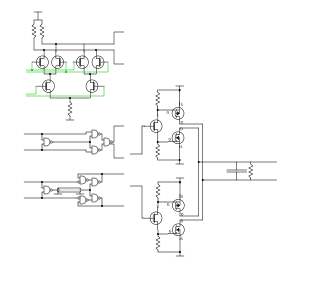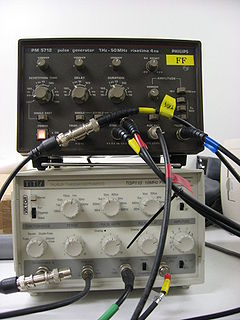In digital logic and computing, a counter is a device which stores the number of times a particular event or process has occurred, often in relationship to a clock. The most common type is a sequential digital logic circuit with an input line called the clock and multiple output lines. The values on the output lines represent a number in the binary or BCD number system. Each pulse applied to the clock input increments or decrements the number in the counter.

A phase-locked loop or phase lock loop (PLL) is a control system that generates an output signal whose phase is related to the phase of an input signal. There are several different types; the simplest is an electronic circuit consisting of a variable frequency oscillator and a phase detector in a feedback loop. The oscillator generates a periodic signal, and the phase detector compares the phase of that signal with the phase of the input periodic signal, adjusting the oscillator to keep the phases matched.
In digital circuits, a shift register is a cascade of flip flops, sharing the same clock, in which the output of each flip-flop is connected to the "data" input of the next flip-flop in the chain, resulting in a circuit that shifts by one position the "bit array" stored in it, "shifting in" the data present at its input and 'shifting out' the last bit in the array, at each transition of the clock input.
Verilog, standardized as IEEE 1364, is a hardware description language (HDL) used to model electronic systems. It is most commonly used in the design and verification of digital circuits at the register-transfer level of abstraction. It is also used in the verification of analog circuits and mixed-signal circuits, as well as in the design of genetic circuits. In 2009, the Verilog standard was merged into the SystemVerilog standard, creating IEEE Standard 1800-2009. Since then, Verilog is officially part of the SystemVerilog language. The current version is IEEE standard 1800-2017.
In automata theory, sequential logic is a type of logic circuit whose output depends not only on the present value of its input signals but on the sequence of past inputs, the input history as well. This is in contrast to combinational logic, whose output is a function of only the present input. That is, sequential logic has state (memory) while combinational logic does not.
In electronics and especially synchronous digital circuits, a clock signal oscillates between a high and a low state and is used like a metronome to coordinate actions of digital circuits.
In digital circuits, a runt pulse is a narrow pulse that, due to non-zero rise and fall times of the signal, does not reach a valid high or low level. A runt pulse may occur when switching between asynchronous clocks; or as the result of a race condition in which a signal takes two separate paths through a circuit, which may have different delays, and is then recombined to form a glitch; or when the output of a flip-flop becomes metastable.

A phase detector or phase comparator is a frequency mixer, analog multiplier or logic circuit that generates a voltage signal which represents the difference in phase between two signal inputs. It is an essential element of the phase-locked loop (PLL).
In electronic instrumentation and signal processing, a time to digital converter is a device for recognizing events and providing a digital representation of the time they occurred. For example, a TDC might output the time of arrival for each incoming pulse. Some applications wish to measure the time interval between two events rather than some notion of an absolute time.

A pulse generator is either an electronic circuit or a piece of electronic test equipment used to generate rectangular pulses. Pulse generators are used primarily for working with digital circuits, related function generators are used primarily for analog circuits.
In digital electronics, synchronous circuit is a digital circuit in which the changes in the state of memory elements are synchronized by a clock signal. In a sequential digital logic circuit, data is stored in memory devices called flip-flops or latches. The output of a flip-flop is constant until a pulse is applied to its "clock" input, upon which the input of the flip-flop is latched into its output. In a synchronous logic circuit, an electronic oscillator called the clock generates a string of pulses, the "clock signal". This clock signal is applied to every storage element, so in an ideal synchronous circuit, every change in the logical levels of its storage components is simultaneous. Ideally, the input to each storage element has reached its final value before the next clock occurs, so the behaviour of the whole circuit can be predicted exactly. Practically, some delay is required for each logical operation, resulting in a maximum speed at which each synchronous system can run.
In digital electronics, an asynchronous circuit, or self-timed circuit, is a sequential digital logic circuit which is not governed by a clock circuit or global clock signal. Instead it often uses signals that indicate completion of instructions and operations, specified by simple data transfer protocols. This type of circuit is contrasted with synchronous circuits, in which changes to the signal values in the circuit are triggered by repetitive pulses called a clock signal. Most digital devices today use synchronous circuits. However asynchronous circuits have the potential to be faster, and may also have advantages in lower power consumption, lower electromagnetic interference, and better modularity in large systems. Asynchronous circuits are an active area of research in digital logic design.
Delta-sigma modulation is a method for encoding analog signals into digital signals as found in an analog-to-digital converter (ADC). It is also used to convert high bit-count, low-frequency digital signals into lower bit-count, higher-frequency digital signals as part of the process to convert digital signals into analog as part of a digital-to-analog converter (DAC).
Clock skew is a phenomenon in synchronous digital circuit systems in which the same sourced clock signal arrives at different components at different times. The instantaneous difference between the readings of any two clocks is called their skew.
A frequency divider, also called a clock divider or scaler or prescaler, is a circuit that takes an input signal of a frequency, , and generates an output signal of a frequency:
A digital delay generator is a piece of electronic test equipment that provides precise delays for triggering, syncing, delaying and gating events. These generators are used in many types of experiments, controls and processes where electronic timing of a single event or multiple events to a common timing reference is needed. The digital delay generator may initiate a sequence of events or be triggered by an event. What differentiates it from ordinary electronic timing is the synchronicity of its outputs to each other and to the initiating event.
Timing closure is the process by which a logic design consisting of primitive elements such as combinatorial logic gates and sequential logic gates is modified to meet its timing requirements. Unlike in a computer program where there is no explicit delay to perform a calculation, logic circuits have intrinsic and well defined delays to propagate inputs to outputs. In simple cases, the user can compute the path delay between elements manually. If the design is more than a dozen or so elements this is impractical. For example, the time delay along a path from the output of a D-Flip Flop, through combinatorial logic gates, then into the next D-Flip Flop input must satisfy the time period between synchronizing clock pulses to the two flip flops. When the delay through the elements is greater than the clock cycle time, the elements are said to be on the critical path. The circuit will not function when the path delay exceeds the clock cycle delay so modifying the circuit to remove the timing failure is an important part of the logic design engineer's task.

In electronics, a signal edge is a transition of a digital signal from low to high or from high to low:

In electronics, a flip-flop or latch is a circuit that has two stable states and can be used to store state information – a bistable multivibrator. The circuit can be made to change state by signals applied to one or more control inputs and will have one or two outputs. It is the basic storage element in sequential logic. Flip-flops and latches are fundamental building blocks of digital electronics systems used in computers, communications, and many other types of systems.
Low Power flip-flops are flip-flops that are designed for low-power electronics, such as smartphones and notebooks. A flip-flop, or latch, is a circuit that has two stable states and can be used to store state information.




